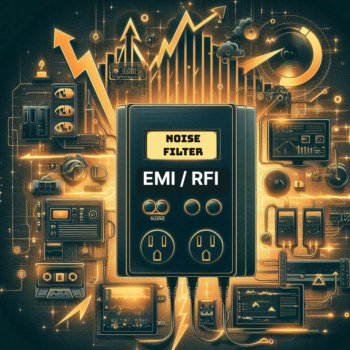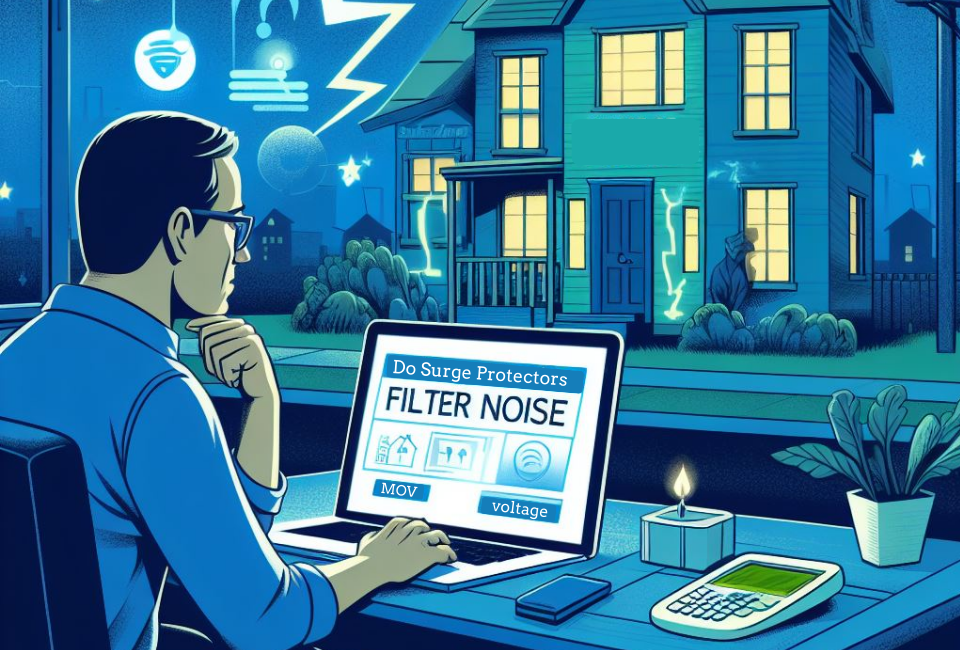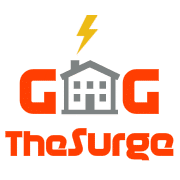Published By: Sean Hudson | Last updated on June 2, 2024 and reviewed by Editorial Team
Surge protectors are an indispensable component for safeguarding electronic devices in our homes. By mitigating the impact of unexpected power spikes, these devices can extend the life and functionality of your electronics.
Alongside surge protection, there is another concern often voiced by our clients seeking optimal performance in their electrical setups: noise filtering. “Noise” in electrical terms, particularly Electromagnetic Interference (EMI) and Radio Frequency Interference (RFI), can disrupt the smooth operation of electronic devices, leading to malfunctions and degradation.
This begs the question: Can surge protectors also help filter out such noise?
In this blog post, we’ll dive into the fundamentals of surge protectors, explore the nuances of electrical noise, and examine whether surge protectors truly can filter and provide a cleaner power supply to your devices.
Understanding Electrical Noise in Power Lines
Definition of EMI/RFI Noise
Electromagnetic Interference (EMI) and Radio Frequency Interference (RFI) are disturbances caused by external electromagnetic fields interfering with electrical circuits.
EMI encompasses any disruption caused by electromagnetic induction or radiation that impacts device functionality, whether it comes from power lines, motors, or other electronic devices.
Radio Frequency Interference (RFI), specifically, refers to the subset of EMI that deals with disturbances at radio frequencies, impacting devices like radios and telecommunications equipment.
Both types of interference can result in unwanted signals being superimposed over the original signals, leading to a degradation of performance and reliability.
How Noise Affects Electronic Devices
The impact of EMI and RFI on electronic devices can range from minor annoyances to serious operational failures. For example, in-home entertainment systems, EMI can cause buzzes or hums over audio outputs, while RFI may lead to distorted images or signals on screens.
In more critical applications, such as medical or industrial settings, these disturbances can result in equipment malfunctions, leading to potentially hazardous situations.
Noise can affect devices in two primary ways: by directly interfering with the electronic circuitry or by inducing voltage spikes.
Direct interference generally results in a degradation of signal quality, as seen in static noise on radio channels or flickering screens. Induced voltage spikes, although less common, can be much more destructive, potentially damaging circuit components or causing data loss.
The severity of interference and its effects can depend significantly on the proximity of the noise source, the type of device, and how well the device is shielded. Devices that contain highly sensitive electronic components are particularly vulnerable to EMI/RFI, and thus require more robust shielding and grounding measures to ensure reliable operation.
Understanding these types of electrical noise and recognizing their potential impacts helps in taking effective measures to protect your devices. Ensuring adequate shielding, using surge protectors with noise filtering capabilities, and maintaining a clean and organized wiring setup are all steps that can help mitigate the risks associated with EMI and RFI.
Do Surge Protectors Filter Noise?
Surge Protectors and Noise Filtering Capabilities
Surge protectors are primarily designed to prevent damage from voltage spikes, but some of our clients wonder if they can also reduce electrical noise.
Noise in electrical terms typically refers to Electromagnetic Interference (EMI) and Radio Frequency Interference (RFI), which can interfere with the performance of electronic devices.
Some surge protectors come with built-in filters intended to dampen this noise. These filters aim to smooth out irregularities in the electrical current that can contribute to EMI/RFI, thereby providing a cleaner power source to connected devices.
Limitations and Effectiveness
While the idea of a surge protector that filters noise is appealing, it’s important to understand its limitations and effectiveness. Not all surge protectors are equipped with the necessary components to filter out EMI/RFI effectively.
Those that do contain filtering capabilities usually feature specific noise-reduction ratings. However, the degree of noise reduction can vary significantly depending on the quality of the surge protector and the type of noise in your environment.
To achieve the best results in both surge protection and noise reduction, I recommended getting a surge protector that specifically mentions enhanced noise filtering capabilities and confirms its specifications against your specific needs.
While some surge protectors can help reduce electrical noise, their primary function is surge protection. For effective noise reduction, look for devices that explicitly list noise filtering features and consider the specific types of noise most prevalent in your setup.
Recommendations for Top Surge Protectors with Noise Filtering
Many high-quality surge protector brands effectively combine surge protection and noise filtering:
- APC Surge Protectors: Known for reliable power protection, APC offers models with high Joule ratings and excellent noise filtering capabilities. Their units often include additional features like USB ports for charging mobile devices, making them a versatile choice for home or office use.
- Belkin Surge Protectors: Belkin is another trusted brand that provides durable surge protectors with advanced features. Many of their models come with enhanced noise filtering, making them superb for audiovisual setups or any environment where maintaining signal integrity is crucial.
- Tripp Lite Isobar Surge Protectors: Tripp Lite’s Isobar models are highly regarded for both commercial and residential use. They feature robust construction, high Joule ratings, and superior noise-filtering technology. The Isobar technology offers multiple isolated filter banks, which significantly improve noise rejection.
Choosing a surge protector from reputable brands ensures not only robust surge protection but also effective noise filtering, safeguarding your valuable electronic devices from unexpected power disturbances and disruptive noise.
By considering the specific needs of your equipment and the particular features of surge protectors, you can make a well-informed decision that provides peace of mind and enhances the performance of your electronic setup.
Features to Look For in Noise-Filtering Surge Protectors
When selecting a surge protector with noise-filtering capabilities, look for technologies such as Metal Oxide Varistors (MOVs) and Electromagnetic Interference (EMI)/Radio Frequency Interference (RFI) filters.
These components help minimize noise alongside surge protection. Check the technical specifications for clamping voltage (the level at which the protector will start to restrict voltage), filtering capabilities (such as attenuation), and response time.
Types of Surge Protectors and Their Effectiveness in Noise Filtering
Surge protectors come in various forms, including strip and whole-home models. Strip surge protectors are commonly used for individual devices or small groups of devices, like your home entertainment system. Whole-home surge protectors, installed at your main electrical panel, provide surge protection for your entire household.
As for their effectiveness in noise filtering, this largely depends on the specific model and the technologies used within. Some premium models offer excellent noise filtration, but always check product reviews and specifications to ensure they meet your needs.
Additional Tips for Minimizing Noise in Electronic Setups
Best Practices for Device Placement and Cable Management
Effective management of device placement and wiring can significantly reduce the risk of noise interference in your electronic setups.
Position sensitive devices away from major sources of electromagnetic interference, such as large motors, fluorescent lights, and other high-powered electrical equipment.
Properly organize and secure cables to avoid tangled messes, which can create cross-talk and other interference patterns. Use cable conduits and shielded cables where possible to further protect against external noise sources.
These simple organizational strategies can have a substantial impact on reducing electronic noise.
Complementary Products and Solutions
In addition to surge protectors with noise filtering capabilities, consider integrating other products that can enhance the overall protection and performance of your electronic equipment.
Uninterruptible Power Supplies (UPS) can provide backup power during outages and also help in smoothing out power fluctuations that include noise elements.
Power conditioners, specifically designed to filter and stabilize power supply, can be an excellent addition to high-end audio and video setups, ensuring that your equipment receives clean power devoid of any harmful fluctuations and noise.
By taking these additional measures, you can create an environment that not only protects your devices from surges and spikes but also ensures that your devices operate with minimal interference and noise.
This dual approach not only prolongs the life of your equipment but also enhances its performance, providing a more reliable and satisfying user experience.
Surge Protectors vs Power Conditioners
When it comes to maintaining the performance and protection of our electronic devices, surge protectors and power conditioners are often mentioned as essential components.
While surge protectors are well known for their ability to safeguard against power surges, power conditioners claim to offer additional benefits by improving the quality of incoming power. However, it’s important to understand the differences between these two devices and determine whether a power conditioner is truly necessary for your setup.
Surge Protectors
Surge protectors, also known as surge suppressors, are designed to protect electrical devices from power spikes and voltage surges. They typically feature integrated metal oxide varistors (MOVs) that absorb excess energy to prevent it from reaching connected devices. Surge protectors are capable of diverting the excess voltage to the ground, minimizing the risk of damage to valuable electronics.
Power Conditioners
On the other hand, power conditioners focus on improving the quality of the power supply coming from the wall outlet. They aim to regulate voltage levels, reduce electrical noise, and eliminate fluctuations or distortions in the power signal. Power conditioners often employ various technologies, such as filters, transformers, and voltage regulators, to achieve these goals.
However, it’s worth noting that most electronic devices already have built-in power supplies that perform the necessary filtering and conversion of the incoming current. These power supplies are designed to provide stable and clean power to the internal components of the device.
Unless you have unique or inexpensive gear that lacks proper power conditioning capabilities or live in an area with inadequate power quality, investing in a power conditioner may not offer significant performance improvements.
Surge Protectors |
Power Conditioners |
|---|---|
| Designed to protect against power surges and voltage spikes. | Targeted at improving power quality by regulating voltage, reducing electrical noise, and eliminating fluctuations. |
| Absorb excess energy and divert it to the ground. | Implement filters, transformers, and voltage regulators to condition and regulate the incoming power signal. |
| Recommended for all electronic devices as a basic form of electrical protection. | Situational necessity depends on unique or inexpensive gear or poor power quality in specific areas. |
To sum up…
Understanding the capabilities and limitations of surge protectors in terms of noise filtering is essential for selecting the right protection for your valuable electronic devices.
With better knowledge, you can make informed choices, ensuring your electronics are safeguarded against both surges and disruptive noise.
Keep these insights in mind the next time you shop for a surge protector to provide the best protection for your technological investments.
🗣️ Share Your Experience
Have you had experiences with surge protectors, or do you have additional tips on minimizing electronic noise? Share your stories or questions in the comments below.
Your insights could help others make informed choices and better protect their electronic investments. Let’s continue this discussion and build a community that stays powered, protected, and informed!










